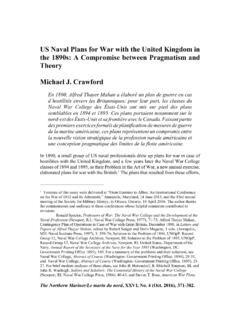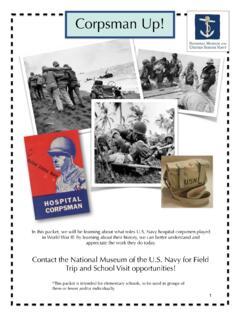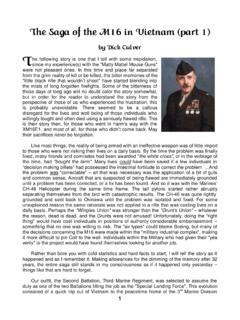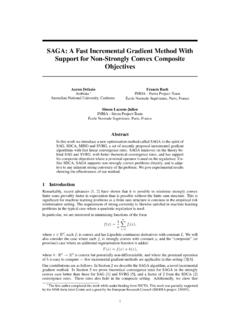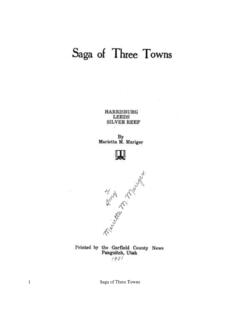Transcription of End of the Saga - NHHC
1 NAVAL HISTORY & HERITAGE COMMAND | THE NAVY AND THE VIETNAM WAREnd of the SagaThe Maritime Evacuation of South Vietnam and Cambodia Malcolm Muir NAVY AND THE VIETNAM WAR Edward J. Marolda and Sandra J. Doyle, Series EditorsEnd of the SagaThe Maritime Evacuation of South Vietnam and Cambodia Malcolm Muir Jr. NAVAL HISTORY AND HERITAGE COMMAND DEPARTMENT OF THE NAVY WASHINGTON, DC 2017 2017 Naval Historical FoundationAll rights portion of this book may be reprinted without written permission from the Naval Historical in the United States of byNaval History & Heritage Command in partnership with the Naval Historical Foundation805 Kidder Breese Street SEWashington Navy Yard, DC 20374-5060w w i stor i lBook design by Dean Gardei and Alan GOVERNMENT OFFICIAL EDITION NOTICEUse of ISBNThis is the official Government edition of this publication and is herein identified to certify its authenticity.
2 Use of 978-0-945274-92-6 is for the Government Publishing Office Edition only. The Superintendent of Documents of the Government Publishing Office requests that any reprinted edition clearly be labeled as a copy of the authentic work with a new of Congress Cataloging-in-Publication DataNames: Muir, Malcolm, 1943 : end of the saga : the maritime evacuation of South Vietnam and Cambodia/Malcolm Muir titles: Maritime evacuation of South Vietnam and CambodiaDescription: First edition. | Washington Navy Yard, DC: Naval History & Heritage Command, in partnership with the Naval Historical Foundation, [2017] | Series: The Navy and the Vietnam War | Includes bibliographical : LCCN 2017010035 | ISBN 9780945274926 (alkaline paper)Subjects: LCSH: Vietnam War, 1961 1975 Naval operations, American. | Vietnam War, 1961 1975 Evacuation of civilians Vietnam (Republic) | Vietnam War, 1961 1975 Evacuation of civilians Cambodia.
3 | Refugees Vietnam (Republic) History 20th century. | Refugees Cambodia History 20th century. | United States. Navy History Vietnam War, 1961 1975. | Vietnam War, 1961 1975 : LCC .M84 2017 | DDC dc23 LC record available at < > The paper used in this publication meets the requirements for permanence as established by the American National Standard for Information Sciences Permanence of Paper for Printed Library Materials (ANSI ). For sale by the Superintendent of Documents, Government Publishing OfficeInternet: ; Phone: toll free 866-512-1800; DC area 202-512-1800; Fax 202-512-2104 Mail Stop: IDCC, Washington, DC 20402-0001 CONTENTSI ntroduction 1 The Collapse in I and II Corps 7 The Final Curtain in Cambodia 13 Preparations for the Saigon Evacuation 17 The Exodus Begins 23 Refugees at Sea 29 Seaborne Evacuation from Vietnam 33 Passage to the Philippines 37 Maritime Refugees 41 Succor in the Philippines and Guam 45 The Recovery of SS Mayaguez 53 The Battle for Koh Tang 59 SIDEBARSVNN Captain Nguyen Xuan Son, 1975 8 The Stalwart Sea Stallion 14 South Vietnamese Aircraft Descend on the Fleet 30A Navy Nurse Hones Her Skills on Guam 48 Henry B.
4 Wilson (DDG -7) 6 0 Acronyms 64 The Author 65 Acknowledgements 65 Publisher s Note 65 Suggested Reading 67S O U TH C HIN A S E AG U LF ofS I A MCape CamauG U LF ofT ONK I NSAIGONQ uang TriHueDanangKontumPhan ThietPhnom Penhly Ph ong SaProvinceNam ThaSam Neua ProvincePlain ofJarsLuang PrabangUdornVientianeHo Chi Minh TrailSenoTcheponeKhoratUbonBangkokSoc TrangPakseAttopeuVoun KhomSambor RapidsHanoiHainanC A M BODI AT H A I L A N DSOU T HV I E T N A ML A O SN O R T HV I E T N A MC HIN A100 105 110 100 105 110 20 15 10 20 15 10 NHHC VN CollectionIndochina1 INTRODUCTIONAs the decades-long struggle in Southeast Asia came to a climax in the spring of 1975, the United States Navy and Marine Corps saved thousands of citizens and pro-American Vietnamese and Cambodians from victorious Communist forces.
5 To the American public, the precipitate withdrawal of the United States from Cambodia, and especially South Vietnam, presented the disconcerting spec-tacle of the abandonment of allies and, on a more human level, of a host of individuals who had worked and fought for common aims. Yet behind the undeniably tragic elements of the picture, the evacu-ations highlighted the skill and courage of American uniformed personnel in the midst of chaos. Setting the stage for this last act in one of America s longest wars was the Paris Agreement of 27 January 1973. Engineered by President Richard M. Nixon and Secretary of State Henry A. Kissinger, this treaty offered the United States peace with honor by bringing home American prisoners of war and ending combat operations for the armed forces. Under terms of the accord, only vestigial rem-nants of the American expeditionary force would stay in South Vietnam to provide training for that country s armed forces.
6 By 1974, about 8,500 personnel remained as civilian advisers, with 5,000 contracted to maintain South Vietnamese military equipment. For America s allies in the region, the Paris Agreement called for elections (that were never held) and a cease-fire. This latter provision meant slightly more than 100,000 North Vietnamese troops remained in South Vietnam. To placate the uneasy South Vietnamese President Nguyen Van Thieu, the Nixon administration secretly offered assurances that if the Communists broke the accord, the United States would intervene with force as it had done in 1972 when American air and naval forces played a critical role in turning back the North Vietnamese Easter Offensive. Despite their smiles, South Vietnamese President Nguyen Van Thieu and President Richard M. Nixon strongly disagreed over the best way to end the conflict in Vietnam.
7 NHHC VN Collection In a comparison of forces following the Paris Agreement, the Saigon government held a strong hand. The Army of the Republic of Vietnam (ARVN) numbered 650,000 regular and regional soldiers, with most units well equipped with American weapons. The Vietnam Air Force (VNAF) was, by some estimates, the fourth largest in the world. The Vietnam Navy (VNN), in terms of sheer numbers of combatant ships (97), ranked among the top ten fleets of the world. Unfortunately, as skeptics had foreseen, the tenuous Paris Agreement quickly unraveled. Anticipating war, both sides set out to secure and enlarge the territories they already held. In Laos, Hanoi-led forces, including the indigenous Pathet Lao, continued their offensive against the Royal Laotian government. In Cambodia, the ARVN launched a large campaign. When this failed, the radical Cambodian Communists (Khmer Rouge) waged an increasingly successful attack on the Phnom Penh government of Lon Nol, whose regime by late 1974 was able to hold little more than the capital itself.
8 Moreover, political turmoil swirled in the United States around the Watergate affair. The scandal involved Nixon s direction of illegal activities and 2his concerted effort to cover up those crimes for which he was compelled to resign from office in August 1974. The odium of Watergate compromised the ability of the executive branch under President Gerald R. Ford to take forceful measures in the event of a major Communist offensive in Southeast Asia. Congress reflected the American public s weariness with the war and it became more assertive in cutting back on funding for Southeast Asian military forces. Many Americans also considered the governments of South Vietnam and Cambodia corrupt and wasteful. The oil crisis of 1973 and subsequent infla-tionary pressures on the economy intensified calls for the Ford administration to slice aid going to South Vietnam and Cambodia.
9 The Communist leadership in Hanoi, embold-ened by Nixon s resignation and realizing direct intervention was not likely, took aggressive steps to exploit the situation. In 1974, North Vietnamese forces began widening and paving the Ho Chi Minh Trail; they even constructed a pipeline from North Vietnam into South Vietnam s Central Highlands. By the end of the year, the North Vietnamese almost doubled their troop strength in the south to 200,000. On the ground, the Communists probed more vigorously, scoring a major success with their seizure and occupation of Phuoc Binh northeast of Saigon. In January, the North Vietnamese overran the entire province of Phuoc Long. As Communist forces in South Vietnam became more aggressive, the Thieu government began plan-ning to withdraw ARVN units from its northern provinces and concentrate them around main population centers, especially Saigon and Danang.
10 But to avoid provoking a panic, South Vietnamese authorities took few concrete steps to implement their fallback the fortunes of American-backed regimes in Southeast Asia spiraled downward in 1974, planners drew up a series of options for withdrawing American citizens and local supporters. These plans, as they evolved, offered leaders a wide menu of choices, ranging from flights by civilian air carriers or military fixed-wing aircraft to embarkation aboard civilian and naval ships to the more extreme measure of helicopter a White House meeting in March 1975, President Gerald R. Ford Jr. (foreground) confers with Ambassador to South Vietnam Graham A. Martin (left), Army Chief of Staff General Frederick C. Weyand, and Secretary of State Henry A. Kissinger over the deteriorating situation in Vietnam. yrarbid Lro. Fd Rlarey GsetruoC3timetable for offensive action.

